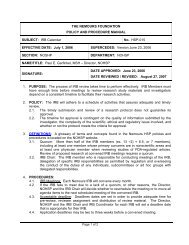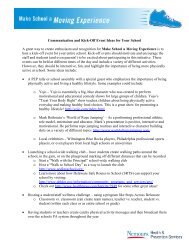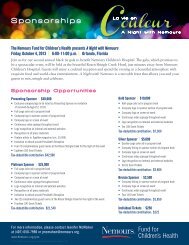Best Practices for Healthy Eating Guide - Nemours
Best Practices for Healthy Eating Guide - Nemours
Best Practices for Healthy Eating Guide - Nemours
Create successful ePaper yourself
Turn your PDF publications into a flip-book with our unique Google optimized e-Paper software.
Picky Eaters<br />
It is natural <strong>for</strong> children to be cautious with new foods.<br />
It can take up to 10–15 tries—actually putting the food<br />
in their mouths—be<strong>for</strong>e they may come to like it. Some<br />
children are especially cautious about trying new foods,<br />
while others use food as a way to be in control.<br />
Use these strategies to create a positive environment and<br />
minimize struggles when trying new foods:<br />
For infants<br />
n Don’t be discouraged by a frown. Infants naturally<br />
prefer salty and sweet tastes, so <strong>for</strong> some fruits and<br />
vegetables it may take up to 10–15 tries <strong>for</strong> a baby to<br />
accept the new food. Don’t give up.<br />
n When offering a new food, serve the infant a food<br />
he/she is familiar with and likes. You could try<br />
alternating bites between the new food and the<br />
familiar food.<br />
For toddlers and older children<br />
n Create a routine that everyone should try and taste<br />
new foods offered at your program. Encourage all<br />
children to take at least one bite of new foods. If a<br />
child is adamantly against it, don’t <strong>for</strong>ce the issue.<br />
n Put a very small portion on the plate to try (like two<br />
peas). Young children may be concerned that they<br />
won’t like the new food, so help them by putting<br />
only a small amount on their plates—it looks less<br />
overwhelming.<br />
n Always offer healthy foods or create a policy that<br />
requires parents to provide well-balanced meals that<br />
align with MyPlate and/or CACFP recommendations.<br />
n Avoid rewarding good behavior or a clean plate with<br />
foods of any kind. Especially avoid <strong>for</strong>cing a child<br />
to finish the “healthy foods” to get to his dessert or<br />
sweets—this can make the healthy food seem like<br />
punishment and <strong>for</strong>ce the child to eat when he is full.<br />
n Offer desserts rarely so children do not expect them at<br />
every meal. When children come to expect dessert, they<br />
may not eat the healthier foods or they may see desserts<br />
as a reward <strong>for</strong> eating healthy food. By not having<br />
dessert as a regular option, you minimize this struggle.<br />
n When introducing a new food, make it a game or<br />
lesson. Remember, it can take 10 to 15 tries <strong>for</strong> a child<br />
to accept a new food. Try offering the new food outside<br />
the meal time. You can make it a classroom lesson and<br />
then have children who are interested in trying the<br />
new food take a taste and share their perceptions. This<br />
creates a desirability to try the new food.<br />
<strong>Best</strong> <strong>Practices</strong> <strong>for</strong> <strong>Healthy</strong> <strong>Eating</strong> 33

















